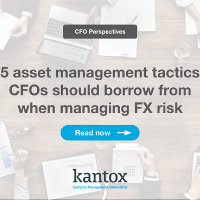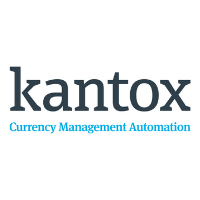CFO Perspectives: 5 asset management tactics CFOs should borrow when managing FX risk
01-08-2022 | treasuryXL | Kantox | LinkedIn |
When managing FX risk, CFOs could learn a lot from the world of asset management, where a revolution —led by indexing— has led to huge gains for investors. But how can you apply this to your business’s FX risk strategy? Watch below the video, or read the article!
In the second edition of CFO Perspectives, we’ll draw from our work with CFOs to explore the parallels between asset management and FX risk. We’ll break down the processes and tools used in asset management which can be applied to your currency management strategy, with some spectacular results.
Over the last couple of decades, the world of asset management —an industry with $100 trillion under management— has been turned upside down by a quite unexpected revolution: indexing. Instead of relying on managers’ capacity to time the markets, these firms have automated the selection of assets by quietly replicating stock indexes.
Can CFOs lead a comparable revolution in currency management?
The answer is: yes, they can! Let us see why and how they can accomplish that feat.
Having embraced indexing early on, two leading firms have assets under management north of $15 trillion. What’s more, they have achieved such a spectacular result with fees that are only a fraction of the fees charged by those who embrace speculation. They have saved, and they are still saving, hundreds of billions in costs to investors.
Similar changes may be afoot in the business world. The term ‘exposure under management’, now used by CFOs and treasurers, comes from the expression ‘assets under management’. More importantly, CFOs are eschewing speculation — just like their cousins in asset management.
When managing currency risk in the one-trillion-a-day forward currency market, CFOs are using more and more digitised, automated solutions.
A random walk for risk managers
Once in a while, a lack of currency hedging or even speculating on an FX market move can yield a positive outcome for CFOs. But luck will run out at some point. Sooner or later, blindfolded by overconfidence, ‘speculative’ risk managers flounder in their vain attempt to time currency markets — with disastrous consequences for themselves and their companies.
Like stock prices and the price of other financial assets, exchange rates are not predictable. They follow ‘a random walk’ in which the forecast is set equal to today’s exchange rate (the spot rate). Accordingly, investors —and risk managers— should embrace markets rather than trying to beat them.
This is the thrust of the analogy between the asset management revolution and the coming revolution in FX risk management, an event that will ultimately enhance the strategic role of CFOs.
5 asset management tactics CFOs should borrow when managing FX risk
Let us go beyond the surface and take a closer look at the key tools and processes used by the most successful companies in asset management. These processes provide a useful template for understanding how CFOs will use Currency Management Automation solutions to manage FX.
We can single out at least five main lines of action:
- Avoid timing the market. Nine out of ten of the so-called geniuses of the investment world have been ‘destroyed’, in terms of comparative performance, by the more modest index funds. Adding insult to injury, the latter have charged only a fraction of the fees. The no-speculation mantra has proved immensely successful in asset management. If one accepts the view that currency markets also follow a ‘random walk’, then there is no reason to expect a different outcome when it comes to FX risk management.
- Achieve operational brilliance. Indexed asset managers know that their success relies on engineering products that achieve operational brilliance by taking the risk of human error out of the equation. Just as indexing is measured by the tracking error between a fund’s rate of return and that of its benchmark, Currency Management Automation is at its core an engineering product that uses Application Programming Interfaces to achieve great precision in currency hedging while allowing managers to seamlessly run the entire FX workflow.
- Implement scalable solutions. Successful asset managers use platforms that provide scalability, which makes it possible to quickly and cheaply enter new markets such as bonds, commodities and others, almost anywhere and in many currencies. The same idea applies to FX automation, as CFOs are set to implement scalable, data-driven pricing and hedging solutions to enter new markets, enabling their companies to buy and sell in more currencies — with FX risk systematically under control.
- Innovate with a purpose. Indexing is one of the few truly beneficial inventions, a technology that has saved investors hundreds of billions of dollars. Similarly, the purpose of automated FX risk management is to allow firms to confidently ’embrace currencies’, reducing costs to customers and ultimately enhancing the value of the business. When it comes to innovation, purpose matters (see: “CFO Perspectives: 3 ways CFOs can use currencies to boost their business’ value”).
- Keep a foot in more than one camp. The world’s largest asset manager keeps a foot in both camps: active asset management and index funds. An entire platform provides a menu from which clients can select whatever financial slice they might fancy. Likewise, CFOs have at their disposal an entire ‘family’ of automated hedging programs and combinations of programs, including balance sheet hedging and a variety of cash-flow hedging programs that respond to their firms’ goals and pricing parameters.










